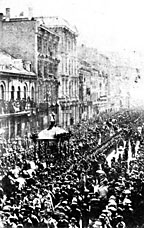
|
|
Saint Patrick's Basilica
(460 Boulevard René-Lévesque West)
A church is built of glass and iron and stone but it takes time and incomprehensible tradition to build a great one. Saint Patrick's Roman Catholic Basilica in Montreal has for 150 years stood foursquare astride a gentle downtown slope known as Beaver Hall Hill. In the 19th century the hill was high ground with a commanding view of the St. Lawrence River, and the church was the focal point for the working-class Irish Catholics who lived in the tumbled slums below: Griffintown, Goose Village and Point St. Charles. Today Saint Patrick's is boxed in by office towers. From the outside it is a massive, strong, almost forbidding place darkened by a century and a half of pollution. Its forecourt--once green and pastoral--has been turned into a parking lot. The basilica's glory is inside, a surprisingly cheerful, vast, uplifting space that author Brian Moore once described as "a brown-and-gold Gothic world of soaring beauty." Virtually every inch of the vaulted interior is embellished. Long, narrow stained-glass windows cast bars of muted amber light across the nave. Veteran newspaper columnist Tim Burke said the effect is "an understated masterpiece of worship. In the majestic silence the struggle of the human spirit seems to rise into a crescendo from time immemorial to eternity." With its pillars, pinnacles, statues, and glowing glass, the interior projects a radiant, sacred presence. The theme of community is written in the detail of its interior design, which is a testimonial to the Communion of the Saints--the union of the faithful on earth with the saints in heaven and the souls in purgatory. The decoration is an instant reminder of St. Augustine of Hippo's belief that all Catholics stand on the shoulders of giants. Or, as one parishioner once put it, at Saint Patrick's "memories of a glorious past come out of the shades and the spirits of great men hover above."
|
 |
|
|
 |
State funeral of Thomas D'Arcy McGee in Montreal, Easter Monday, April 18, 1868. Looking west on St. Jacques from St. Pierre Street.
(Thomas D'Arcy McGee Collection, Concordia University Archives)
|
Saint Patrick's has had a parade of distinguished communicants: Louis Riel's Aunt Lucie was married there; the assassinated father of Canadian Confederation D'Arcy McGee was buried from the church; the French-Canadian poet Émile Nelligan was baptised there; Montreal Mayors Dr. William Hales Hingston, James John Guérin, and James McShane were major boosters; and Canadian Pacific Railway baron, Lord Thomas Shaughnessy an important benefactor. Governor General Georges Vanier's mother, Margaret Maloney, worshipped there as young girl. Toronto's Emmett Cardinal Carter, his brother Alex, a former bishop of Sault Ste. Marie, and the late Gerald Berry, a former Archbishop of Halifax, were altar boys at Saint Patrick's. William Power, the bishop of Antigonish, N.S. sang in its boys' choir. Quebec Premier Maurice Duplessis made it his church in Montreal. Prime Minister John Turner was one of its wardens. Prime Minister Brian Mulroney's youngest son, Nicholas, made his first communion from the church. It is where world figure skating champion and two-time Olympic bronze medalist Isabelle Brasseur married American pairs skater Rocco (Rocky) Marval.
Parent church to Montreal's 250,000 English-speaking Roman Catholics, Saint Patrick's was built between 1843 and 1847 by an association of clerics from France, the Company of Priests of Saint Sulpice. The building that stands is much larger and far more important in stature than the one originally planned. At first the church was to be nothing more than an auxiliary chapel of the existing French-language parish church of Notre Dame on Place d'Armes. Events, however, conspired to bestow Saint Patrick's with more authority and influence than anyone at the time could have envisioned.
Excerpt from Saint Patrick's of Montreal:
The Biography of a Basilica by Alan Hustak.
|



